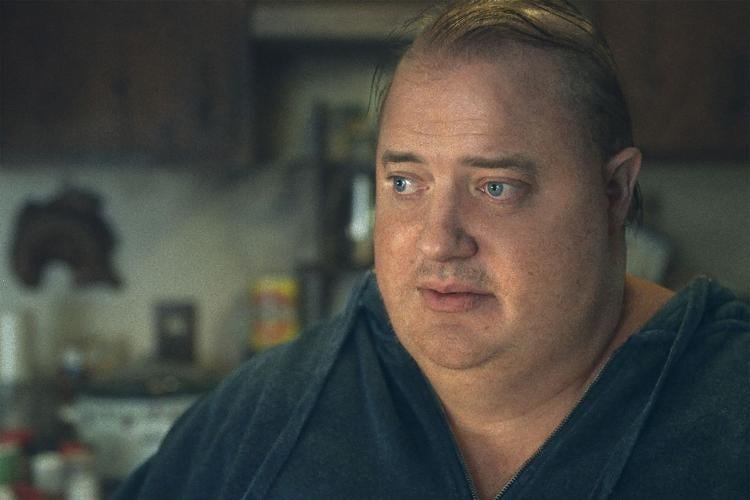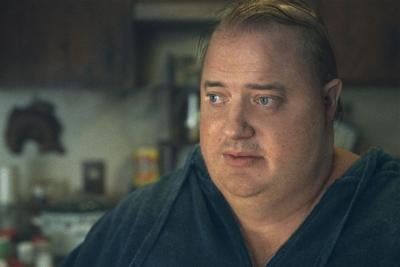Director Darren Aronofsky presents this film in an aspect ratio of 4:3, which was the universal standard for 35 mm celluloid. Aronofsky though shot this film using a digital camera, so the aspect ratio isn't done out of respect to traditional celluloid but more to emphasize his protagonist and his weight. His protagonist is suffering from class III obesity and Aronofsky clearly wants his protagonist to not only fill but consume the frame. A 4:3 ratio would better help that, and it would also underline how boxed in the protagonist is or feels. The aspect ratio when projected on a widescreen theater gives the image a more square-like box shape.
Brendan Fraser (The Mummy and Gods and Monsters) stars as Charlie, an online literature professor who is confined to his house, due to his morbid obesity. He's gay and his obesity was triggered after his boyfriend committed suicide. He clearly developed an eating disorder as a result. He's ballooned to a point that he can't stand or walk without help, either a bariatric rollator or a wheelchair. He's probably north of 400 pounds, which this film depicts him nearly naked, so that we see all those pounds, using techniques that will likely garner this film an Oscar nomination for Best Makeup and Hairstyling.

Hong Chau (The Menu and Downsizing) co-stars as Liz, the nurse that comes to Charlie's house everyday to help take care of him. She seems to be at her wit's end though. This is mostly because Charlie refuses to go to a hospital and get proper medical care, especially after a recent test revealed he has congestive heart failure. Liz knows without proper care, he'll likely die within a week. She's frustrated he won't go to a hospital, but she doesn't seem like she's willing to do much more than bring him fatty foods.
Sadie Sink (Stranger Things and Fear Street: Part Two - 1978) also co-stars as Ellie, the daughter of Charlie. She hates her father. She even calls him disgusting. She says it's not about his size or how he looks. She calls him disgusting because when she was eight, he left her and her mother for his boyfriend. About a decade ago, he was married but fell in love with another man and ended his marriage. Ellie resents him for that because she felt abandoned and unworthy.

The film is mainly about Charlie and Ellie reckoning with what happened and his decision to leave. It's also about Charlie trying to reconcile and repair his relationship with Ellie. She's really resistant to that and won't really allow him to explain or even give context of his absence or distance. As a result, the film doesn't ever give Charlie an opportunity to explain or give context. The film then pivots to being about Charlie trying to heal Ellie of her anger and self-doubt, when it comes to her writing, including trying to dispel this idea that she isn't a good person.
Given the structure of the film, adapted from a play by Samuel D. Hunter, it limits what could have occurred. For example, we never get any scenes outside of Charlie's home, which could help inform us more of who Ellie is. Aronofsky does incorporate flashbacks and flourishes that briefly take us outside Charlie's apartment, but those are brief glimpses. It's not enough to fill in the gaps presented here that is Charlie and Ellie's history.

Samantha Morton (John Carter and Minority Report) plays Mary, Ellie's mother who has sole custody and doesn't allow Charlie to be near Ellie. For her to get sole custody, it would mean Charlie gave up his parental rights or there was a legal battle in which Charlie lost. For that to happen, it would mean things got nasty. Whatever happened during the custody fight, it doesn't seem to matter because Ellie's behavior as a teenager has become problematic for her mother. Mary dismissing her daughter's behavior as her being "evil" perhaps tells us all we need to know about Mary, but it feels as though Hunter's screenplay could have developed more of that custody battle and Mary's parenting.
Ty Simpkins (Iron Man 3 and Insidious) plays Thomas, a Christian missionary who becomes involved with Ellie, not in a romantic sense. Through him, the film attempts to reckon with Ellie's behavior, as well as expose the homophobia that Charlie has experienced. Simpkins is a great young actor, but I'm not sure his role in this film was all that necessary or contributed all that much.

Fraser is likely to get an Oscar nomination for his role here. He's charming pretty much from beginning to end, despite all the prosthetics. He's also effectively heartbreaking in critical moments. The controversy that surrounded this film speaks to representation of fat or overweight people. Farah Fleurima at The New York Times wrote a great article that breaks down that issue.
What makes it problematic here is that Charlie's weight or class III obesity wasn't necessary for the narrative. Charlie's primary health concern is congestive heart failure, which can be caused by obesity, but there are other causes as well. It didn't have to be obesity. Hunter's script made Charlie morbidly obese probably because he wanted an allusion to the titular animal, which is referenced through Charlie's love of an essay about Herman Melville's Moby-Dick.

However, it could be that Hunter wasn't comparing Charlie to a large, blubbering sea creature. Hunter's comparison could have been Charlie to Ahab. What makes it rather unacceptable is the depiction of Charlie as this "disgusting" human being. Yes, he's called that by Ellie but put into context as not being about his weight or looks. Yet, at no point, does Aronofsky's film depict Charlie in any other light that would make him not look disgusting. His home is unkempt. He's constantly sweaty and when he's seen eating, it's also creating more of a mess. It's as if to suggest that obese people can't be clean or tidy.
If anyone has seen This Is Us (2016), there was an episode in the sixth and final season called "The Hill" that focused on the overweight character of Kate. That episode ends similarly to this film. The familial issues are vastly different, but that series never portrayed Kate as a fat slob, even in her lowest. She was portrayed as outwardly beautiful and fashionable. Here, Charlie is never given a moment where he basically isn't sitting in his own filth as a fat slob.
Pop star Rihanna started a fashion line called Savage X Fenty. A couple of years ago, she made headlines by putting plus-size men in the forefront as models of that line. Steven Green, aka Steven G, is one of those models. He's one of several plus-size men who have been embraced in the modeling world and certainly on social media. VirgoVonnie is one such social media and fashion icon, operating in that space. In the independent queer media space, Doug Lanway's BearCity (2010) and the series Where the Bears Are (2012) also did a lot to portray plus-size or overweight men as beautiful or sexy, not despite but because of their weight. Fraser's performance of course shows Charlie's inner beauty, his love and compassion, but Aronofsky could've done more to portray his outer beauty as well.
Rated R for language, some drug use and sexual content.
Running Time: 1 hr. and 57 mins.
In theaters.

































